Spot LNG price drops to level that's not too hot, not too cold
(Reuters) - The spot price of liquefied natural gas (LNG) in Asia is in the sweet spot of being low enough to boost buying interest, but not so low that it sparks a surge in demand.

The price for LNG delivered to north Asia dropped to $9.80 per million British thermal units (mmBtu) in the week to May 19, its first foray below the $10 level in two years.
The price has slid 74% since its northern winter peak of $38 per mmBtu on Dec. 16, and is down 86% from the record high of $70.50, hit in August last year as Europe sucked up all available cargoes amid fears of the total loss of Russian pipeline supplies.
The decline in spot LNG prices has seen demand in key Asian importers hold steady, according to data compiled by commodity analysts Kpler.
Asia is expected to import 20.81 million tons of the super-chilled fuel in May, the same result as was recorded in April and down slightly from March's 22.16 million.
While a steady-as-she-goes outcome may seem somewhat disappointing at first glance, especially given the price decline, it's actually stronger than appearances given that LNG is in the shoulder period of seasonally weaker demand between the peaks of the northern winter and summer.
The seasonal softness can be seen in Japan's May imports dropping to an expected 4.24 million tons from 5.0 million in April and 5.55 million in March.
Japan reclaimed the title of the world's biggest LNG importer from China last year, as Chinese utilities largely opted out of the spot market when prices surged following Russia's invasion of Ukraine.
Chinese buyers have returned to the market, but their purchases have been modest so far in 2023, with an estimated 5.23 million tons slated to arrive in May, little changed from April's 5.33 million and 5.46 million in March.
It's believed that Chinese utilities require a spot price below $10 per mmBtu in order for LNG to be competitive in the domestic market, so the decline below this level last week may act to spur some new buying interest in coming weeks.
The price-sensitive LNG buyers in South Asia have also been returning to the spot market in recent months, with India, the fourth-largest importer in Asia, expected to land 1.91 million tons in May.
This is slightly down from 1.98 million in April, but up from March's 1.84 million and also well above the 1.46 million in January and the 1.32 million in December, when spot prices were still elevated.
However, it's likely that the decline in spot prices will only boost demand from June onwards, and there are some early signs that this is already happening.
June pick-up
Preliminary June imports for Asia are assessed by Kpler at 19.36 million tons, almost matching the May figure, which is a robust signal given the certainty that more cargoes will be assessed in coming weeks.
The lower spot price in Asia is also working to boost buying interest in Europe, with May imports expected at 12.28 million tons, up a smidgeon from April's 12.27 million.
Spot LNG prices in Asia are at competitive levels with the main benchmarks in Europe, with the benchmark British day-ahead contract ending at 66.75 pence per therm on May 19, equivalent to $8.18 per mmBtu.
The Dutch TTF front-month contract ended last week at 30.30 euros per megawatt hour, equivalent to about $9.62 mmBtu.
The question for the market is at what point the spot price for LNG in Asia falls far enough to provide a significant boost to buying, especially given the summer demand peak is coming.
The forward curve for LNG futures traded in New York suggests that point is soon, with the curve in contango and the July contract ending at $10.35 per mmBtu on May 19, while August was higher still at $11.11.
The opinions expressed here are those of the author, a columnist for Reuters.
Related News
Related News

- Credit Agricole says it will not fund two major LNG projects
- Aramco awards $7.7-B contracts to add 1.5 Bscfd of raw gas to Fadhili Gas Plant
- Japan's JERA suspends output at 4 gas-fired power plants to secure LNG stocks
- LNG Canada expansion to be decided by 2025
- TotalEnergies: Papua LNG project requires 'more work' to reach final investment decision
- Technip Energies awarded a major LNG contract for the North Field South Project by QatarEnergy
- Shell publishes Energy Transition Strategy 2024
- QatarEnergy to charter 19 new LNG vessels expanding fleet further
- Aramco awards $7.7-B contracts to add 1.5 Bscfd of raw gas to Fadhili Gas Plant
- Mabanaft announces successful acquisition of WESTFA Energy GmbH



Comments